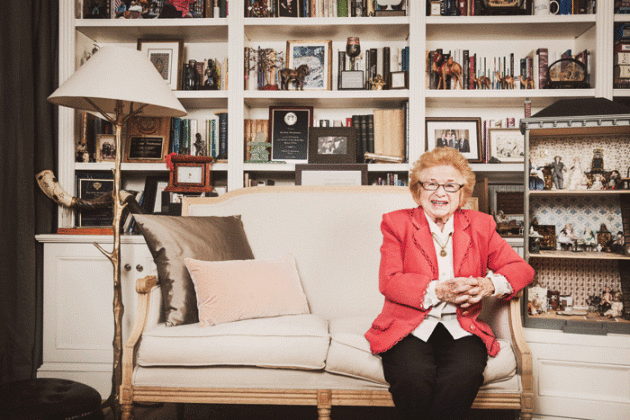
by Matilda Feder
Dr. Ruth Has a Dollhouse, Too.

“A dollhouse is not just a toy, it represents wishes,” says Dr. Ruth. Photo by Chris Chrisman.
Dr. Ruth Westheimer is 88 years old, but you wouldn’t know it when she took the stage Monday night at the National Building Museum to talk about her incredible life, dollhouses, and of course, her career as a psycho-sex therapist, with NPR’s Special Correspondent Susan Stamberg.
The National Building Museum has the wonderful Small Stories exhibition on display— a selection of the Victoria and Albert’s very best dollhouses and the “Dream House” installation of imaginatively crafted rooms created by American designers and artists.
But why talk to Dr. Ruth about dollhouses?
Stamberg asked Dr. Ruth that question first, and she had the answer right away (not, of course, before cracking a sex joke. She had to start the evening with a sex joke.)
“A dollhouse is not just a toy, it represents wishes,” she said. Dr. Ruth specifically spoke about the years of her life between the two World Wars, saying that to her dollhouses that represent those years are “almost sacred.”
Although Dr. Ruth is now the celebrated author of 38 books, executive producer of five documentaries, mother of two, and a cultural icon, Dr. Ruth has lived through considerable trauma. Born in Frankfurt in 1928, Dr. Ruth was sent to Switzerland after the Night of Broken Glass, where she lived in a school that became an orphanage with caregivers who were traumatized refugees themselves. She said that “even as a child of ten and a half there was this sense deep down that I would not see my parents again.”
Without even her favorite doll, Matilda (who given away to an even younger girl on the train), how did Dr. Ruth cope?
With dreams, fantasies, diaries, and dollhouses.
“We wrote little essays, fantasies, of our dreams,” Dr. Ruth said. She spoke of her first boyfriend, who would share his schoolbooks secretly with Dr. Ruth, as the girls weren’t allowed to go to school. “He made my very first dollhouse. He said, we’ll get married, and there was even a children’s room. He still lives – I see him every year.”
Dr. Ruth said she learned through her work that people can express feelings through play that they can’t express through words. Through diaries, dollhouses and letters, Dr. Ruth and the children she knew dealt with their trauma in every way they could.
Dr, Ruth said she is in touch with many of the other children from the home in Switzerland. She did a study on the group, which helped her find them, and has kept contact. “All those kids who were with me felt we needed to do something for Tikkun Olam, for the world,” she said, explaining that there was a sense of obligation to repair the world since one and a half million children died, and they lived. “With a dollhouse,” Dr. Ruth said, “you can do that. You can decide what happens.”
Dr. Ruth’s connection between dollhouses and Tikkun Olam makes particular sense, I think, in light of her career. As a psycho-sex therapist, she gave advice to hundreds of people. Over the years, she must have heard many stories of unsatisfying relationships and cruel behaviors. In her dollhouses, she could create perfect worlds with perfect families.
She certainly has enough dollhouses to work with. Dr. Ruth told us she has two tall dollhouses and five or six small ones. A friend from the New School, Lou Lieberman, made them for her after she saw his skill in constructing dollhouses as a hobby. “I said, the next one has to be mine. I promised him good sex for the rest of his life. I told him, you need to make a dollhouse that reflects the happy years of my life.”
For Dr. Ruth, that means the period of her childhood before the war, when her family was alive. She only buys the dollhouse furniture in England, and the dollhouses are very Jewish, filled with as many miniature Jewish features as possible.
“I had no control over my life,” she explains. “I did not want to leave Germany; I did not want to go to Switzerland. With the dollhouses, I have control. I put the parents, and they stay there. I put the children, and they’re going to stay there. It’s not just thinking backward. It’s the comfort of the years propelling me forward.”
Dr. Ruth’s talk was particularly meaningful for me. My grandmother was a Holocaust survivor, like Dr. Ruth. And like Dr. Ruth, she loved dollhouses. She was artistic and good with her hands, and there is a dollhouse she started to build, half completed in my parents’ basement. She finished the tiling in the bathroom and the tiny hardwood floors, but not the electrical wiring before her arthritis got worse. I’ll have to finish the dollhouse for her, so the more perfect world she dreamed about will finally be completed.
The views and opinions expressed in this article are the author’s own and do not necessarily reflect those of Lilith Magazine.